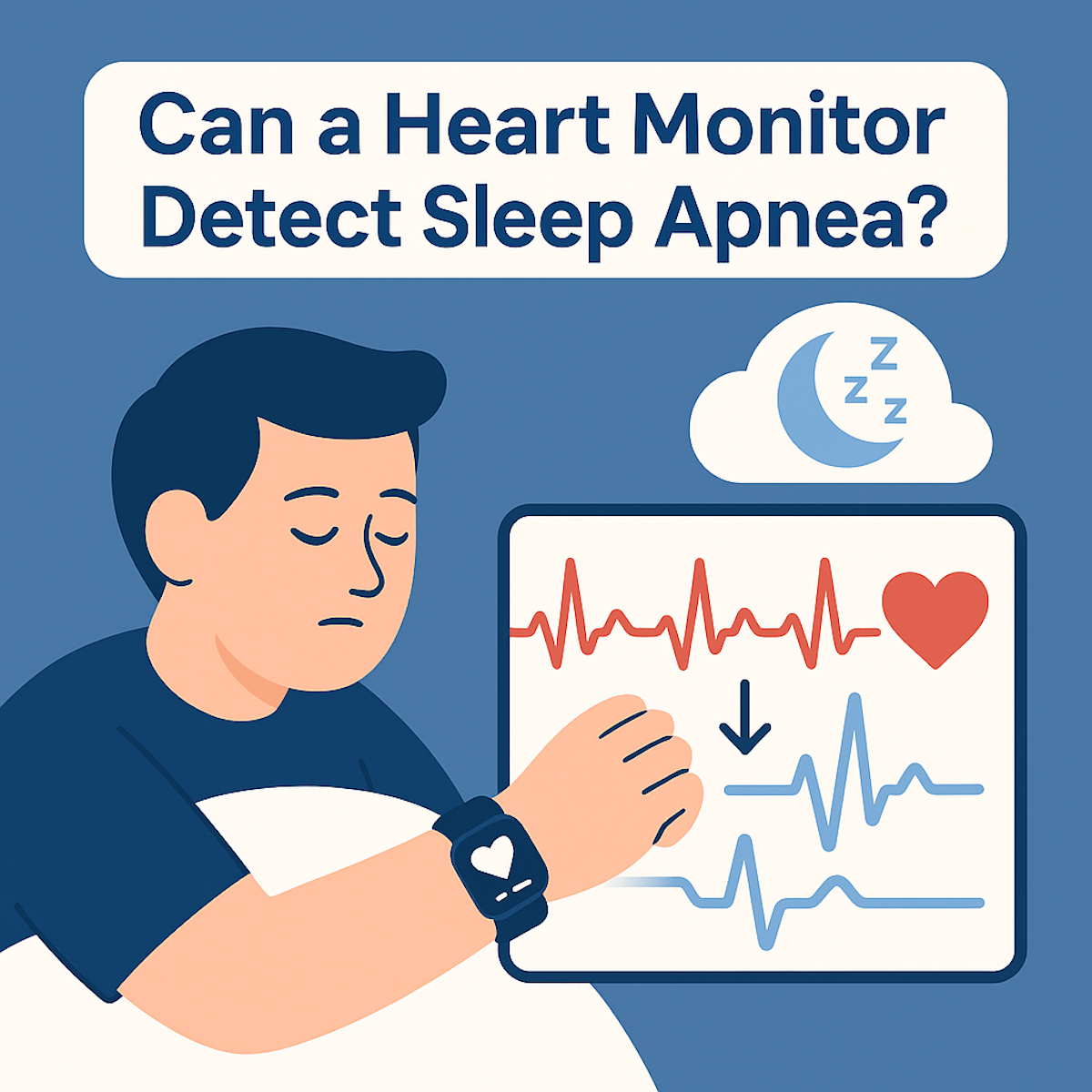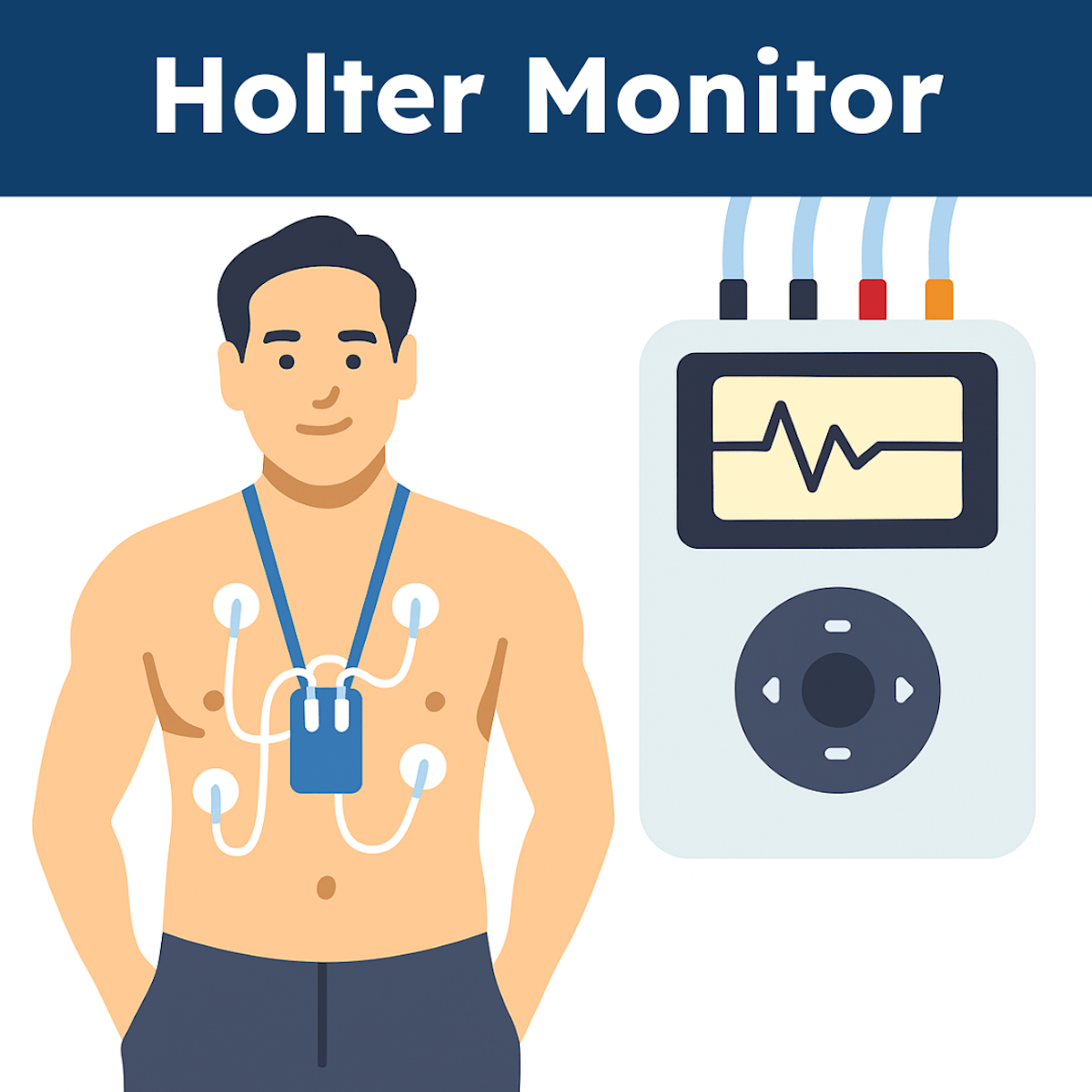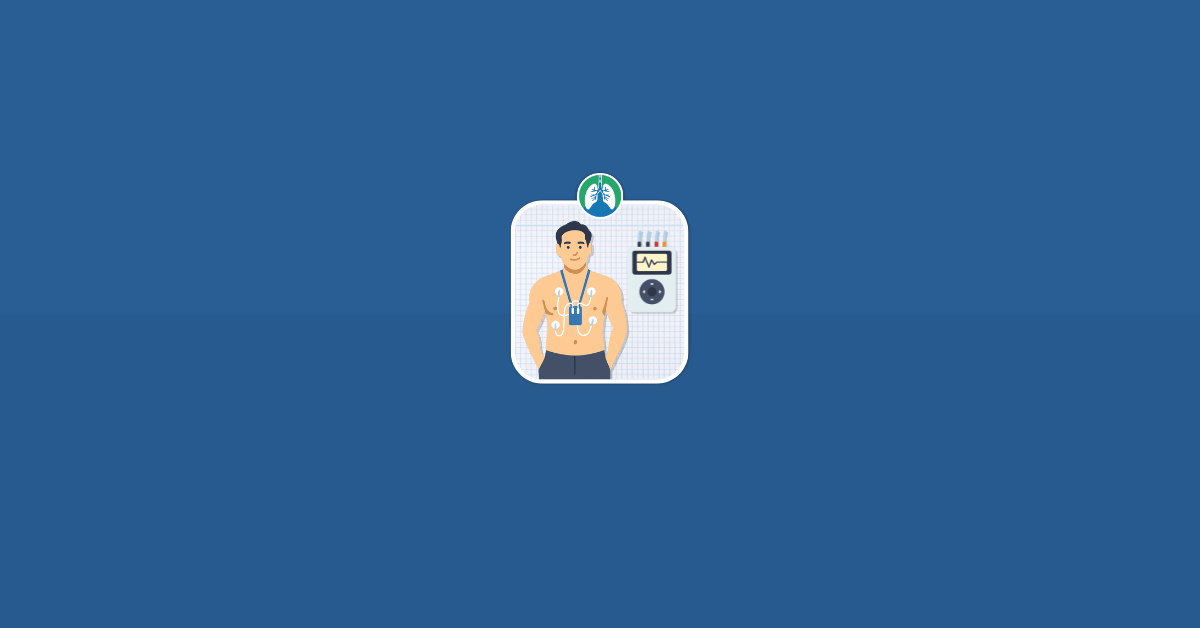Sleep apnea affects millions of people worldwide, yet many cases go undiagnosed. As wearable technology becomes increasingly sophisticated, many wonder whether their heart rate monitors and fitness trackers can detect this potentially serious sleep disorder.
Understanding the relationship between heart monitoring technology and sleep apnea detection can help you make informed decisions about your health monitoring.
Download our free guide that has over 100+ of the best tips for healthy lungs.
Can a Heart Monitor Detect Sleep Apnea?
A heart monitor alone cannot directly detect sleep apnea, but it may show signs that suggest its presence. Sleep apnea often causes changes in heart rate, such as bradycardia (slow heart rate) during apnea events and tachycardia (fast heart rate) upon arousal. These fluctuations may appear on a heart monitor, prompting further investigation.
However, a definitive diagnosis of sleep apnea requires a sleep study (polysomnography), which monitors breathing patterns, oxygen levels, and other physiological data during sleep. While heart monitors can offer clues, they are not a substitute for proper sleep apnea testing.

What is Sleep Apnea?
Sleep apnea is a sleep disorder characterized by repeated interruptions in breathing during sleep. These interruptions, called apneas, can last from a few seconds to more than a minute and may occur hundreds of times per night. The most common type, obstructive sleep apnea (OSA), occurs when throat muscles relax and block the airway during sleep.
Common symptoms include loud snoring, gasping for air during sleep, excessive daytime fatigue, morning headaches, and difficulty concentrating. Left untreated, sleep apnea can lead to serious health complications, including high blood pressure, heart disease, stroke, and diabetes.
How Heart Monitors Work
Modern heart rate monitors utilize photoplethysmography (PPG) technology, which involves shining light through the skin and measuring the amount of light absorbed by blood vessels. As your heart beats, blood flow changes, causing variations in light absorption that the device translates into heart rate data.
Advanced monitors can also track heart rate variability (HRV), which measures the variation in time between heartbeats. This metric provides insights into your autonomic nervous system function and overall cardiovascular health.
The Heart-Sleep Apnea Connection
Sleep apnea creates distinct patterns in heart rate and oxygen levels. When breathing stops during an apneic episode, several physiological changes occur:
- Heart rate fluctuations: The heart rate typically slows during the apnea, then spikes when breathing resumes
- Blood oxygen drops: Oxygen saturation decreases during breathing interruptions
- Blood pressure changes: Repeated episodes can cause significant cardiovascular stress
- Autonomic nervous system disruption: The body’s stress response is repeatedly activated
Note: These patterns create recognizable signatures that sophisticated monitoring devices can potentially identify.
Current Capabilities of Heart Monitors
Consumer Wearables
Most consumer heart rate monitors and fitness trackers can detect some sleep-related patterns:
- Sleep staging: Many devices can distinguish between light sleep, deep sleep, and REM sleep
- Heart rate trends: They track overnight heart rate patterns and variability
- Movement detection: Accelerometers can identify restless sleep or frequent awakenings
- Blood oxygen monitoring: Some newer models include pulse oximetry features
Note: These devices are not medical diagnostic tools and cannot be used to definitively diagnose sleep apnea.
Medical-Grade Monitors
Professional medical monitors used in sleep studies provide much more comprehensive data:
- Continuous oxygen monitoring: Precise measurement of blood oxygen saturation
- Respiratory effort tracking: Monitoring of chest and abdominal movements
- Airflow measurement: Direct detection of breathing interruptions
- Brain wave monitoring: EEG data to determine sleep stages accurately
Limitations of Heart Monitors for Sleep Apnea Detection
While heart monitors can provide valuable insights, they have several limitations for sleep apnea detection:
Accuracy Constraints
- Movement artifacts: Physical movement can interfere with heart rate readings
- Sensor positioning: Improper device placement can affect accuracy
- Individual variations: Heart rate patterns vary significantly between people
- Other conditions: Various medical conditions can cause similar heart rate patterns
Diagnostic Limitations
- Screening vs. diagnosis: Heart monitors can suggest possible sleep apnea but cannot provide a definitive diagnosis
- Severity assessment: They cannot accurately determine the severity of sleep apnea
- Type differentiation: They cannot distinguish between different types of sleep apnea
- Clinical correlation: Medical evaluation is needed to interpret findings properly
What Heart Monitors Can and Cannot Do
What They Can Do:
- Identify unusual overnight heart rate patterns
- Track sleep quality trends over time
- Detect frequent awakenings or restless sleep
- Monitor blood oxygen trends (in equipped devices)
- Provide data to discuss with healthcare providers
- Serve as a screening tool to identify potential issues
What They Cannot Do:
- Provide a medical diagnosis of sleep apnea
- Determine the specific cause of sleep disturbances
- Replace professional sleep studies
- Accurately measure breathing interruptions
- Assess the full impact on your health
- Guide treatment decisions independently
What Is a Holter Monitor?
A Holter monitor is a portable electrocardiogram (ECG) device that continuously records your heart’s electrical activity, typically for 24 to 48 hours. Unlike a standard ECG performed in a doctor’s office, which captures only a brief snapshot of heart activity, a Holter monitor provides a comprehensive view of how your heart behaves during daily activities, including sleep.
The device consists of small electrodes attached to your chest that connect to a small recording unit, usually worn on a belt or carried in a pocket. Patients go about their normal routines while the monitor silently tracks every heartbeat, creating a detailed record that physicians can later analyze for irregularities.

Can Holter Monitors Detect Sleep Apnea?
While Holter monitors cannot directly diagnose sleep apnea, they can detect cardiac changes that strongly suggest its presence. The monitor may reveal several telltale patterns:
- Cyclical Heart Rate Changes: During sleep apnea episodes, heart rate typically slows down (bradycardia) during the breathing pause, then rapidly increases (tachycardia) when breathing resumes. This cyclical pattern, when observed repeatedly during sleep hours, can indicate sleep apnea.
- Arrhythmias During Sleep: The presence of heart rhythm abnormalities specifically during sleep hours, particularly if they occur in patterns consistent with breathing interruptions, may suggest underlying sleep apnea.
- Heart Rate Variability: Sleep apnea can cause characteristic changes in heart rate variability—the natural variation in time between heartbeats—which a Holter monitor can detect.
Limitations of Holter Monitoring for Sleep Apnea
Despite these cardiac indicators, Holter monitors have significant limitations when it comes to sleep apnea detection:
- Indirect Evidence Only: The monitor can only detect the cardiovascular consequences of sleep apnea, not the breathing interruptions themselves. These heart rhythm changes can have other causes unrelated to sleep apnea.
- Not All Cases Are Detectable: Some people with sleep apnea may not show obvious cardiac changes on a Holter monitor, particularly those with milder forms of the condition.
- Requires Expert Interpretation: Recognizing sleep apnea-related patterns on a Holter monitor requires specialized knowledge and experience. Not all healthcare providers may be trained to identify these subtle indicators.
- Limited Time Frame: Standard Holter monitoring typically lasts only 24-48 hours, which may not capture representative sleep patterns, especially if someone’s sleep apnea varies from night to night.
The Gold Standard: Sleep Studies
The definitive test for diagnosing sleep apnea remains the sleep study, also known as polysomnography. This comprehensive test monitors multiple bodily functions during sleep, including:
- Brain wave activity
- Eye movements
- Muscle activity
- Heart rhythm
- Breathing patterns
- Blood oxygen levels
- Airflow through the nose and mouth
Note: Home sleep apnea tests (HSATs) are also available, offering a more convenient but somewhat less comprehensive option for diagnosing sleep apnea in certain patients.
When Might a Holter Monitor Suggest Sleep Apnea?
Healthcare providers might suspect sleep apnea based on Holter monitor results in several scenarios:
- Unexplained Nocturnal Arrhythmias: If the monitor shows heart rhythm problems that occur specifically during sleep hours without an obvious cardiac cause, sleep apnea might be considered.
- Cyclical Heart Rate Patterns: Repeated patterns of heart rate slowing followed by acceleration during sleep hours can be suggestive of sleep apnea episodes.
- Combined with Symptoms: When Holter findings are combined with classic sleep apnea symptoms like loud snoring, witnessed breathing pauses, excessive daytime sleepiness, or morning headaches, the likelihood of sleep apnea increases significantly.
Clinical Implications and Next Steps
If a Holter monitor reveals patterns suggestive of sleep apnea, healthcare providers typically recommend:
- Sleep Study Referral: The most appropriate next step is usually a formal sleep study to confirm the diagnosis and determine the severity of sleep apnea.
- Cardiovascular Evaluation: Given the strong connection between sleep apnea and heart disease, a comprehensive cardiac evaluation may be warranted.
- Risk Factor Assessment: Providers will likely evaluate other risk factors for sleep apnea, including obesity, neck circumference, family history, and lifestyle factors.
When to Seek Professional Evaluation
Consider consulting a healthcare provider if your heart monitor data shows:
- Consistent unusual heart rate patterns during sleep
- Frequent drops in blood oxygen levels
- Regular sleep disruptions or poor sleep quality scores
- Patterns that correlate with daytime symptoms
Note: Seek medical evaluation if you experience classic sleep apnea symptoms such as loud snoring, witnessed breathing interruptions, excessive daytime sleepiness, or morning headaches.
The Future of Sleep Apnea Detection
Technology continues to advance rapidly in this field. Researchers are developing:
- Improved algorithms: More sophisticated analysis of heart rate and oxygen data
- Multi-sensor approaches: Combining heart rate, movement, and sound detection
- Artificial intelligence: Machine learning models trained on sleep study data
- Contactless monitoring: Radar and other technologies that don’t require wearing devices
Note: Some studies suggest that advanced algorithms analyzing heart rate variability and oxygen saturation data from consumer devices may achieve reasonable accuracy for screening sleep apnea, although clinical validation is ongoing.
Making the Most of Your Heart Monitor Data
To maximize the value of your heart monitor for sleep health:
Optimize Data Collection
- Wear your device consistently and properly positioned
- Ensure the device is charged and functioning correctly
- Maintain consistent sleep schedules when possible
- Note any factors that might affect readings (illness, medications, etc.)
Track Patterns Over Time
- Look for consistent trends rather than single-night anomalies
- Document correlations with how you feel during the day
- Note any changes in patterns over weeks or months
- Keep a sleep diary to complement device data
Use Data Effectively
- Share comprehensive data with healthcare providers
- Don’t rely solely on device interpretations
- Consider device data as one piece of a larger health picture
- Be prepared to pursue professional sleep testing if indicated
FAQs About Heart Monitors and Sleep Apnea
Can a Cardiologist Tell If You Have Sleep Apnea?
A cardiologist may suspect sleep apnea based on symptoms, heart rhythm irregularities, or cardiovascular complications like hypertension or atrial fibrillation. While they can’t diagnose it directly, they may refer you for a sleep study if they notice abnormal patterns on heart monitors or if you report excessive daytime sleepiness, loud snoring, or nighttime breathing pauses.
Note: Sleep apnea can significantly impact heart health, so cardiologists often play a key role in recognizing signs and initiating further evaluation.
What Does Sleep Apnea Look Like on Heart Rate?
Sleep apnea can cause cyclical heart rate changes. During apnea episodes, the heart rate may slow down (bradycardia) due to reduced oxygen levels, followed by a sudden increase (tachycardia) when breathing resumes. This pattern may repeat throughout the night.
These fluctuations can be detected on a heart rate monitor or ECG but are not specific enough to confirm sleep apnea. Instead, they may prompt further investigation, such as a referral for a sleep study or home sleep apnea testing.
Would a Heart Monitor Show Sleep Apnea?
A standard heart monitor may not directly show sleep apnea, but it can reveal irregularities caused by it. For example, heart rate variability, episodes of bradycardia, and sudden spikes in heart rate may suggest disordered breathing during sleep. However, these signs are not definitive.
Heart monitors provide supporting clues, not diagnoses. Confirming sleep apnea requires a sleep study that records breathing, oxygen levels, and sleep patterns in addition to heart activity.
Is There a Monitor to Detect Sleep Apnea?
Yes, there are specific monitors designed to detect sleep apnea. These include home sleep apnea testing devices and in-lab polysomnography, both of which measure breathing effort, oxygen saturation, airflow, and heart rate while you sleep.
Some wearable health devices and advanced monitors can suggest sleep disturbances, but only FDA-approved sleep study equipment can accurately diagnose sleep apnea. If you suspect sleep apnea, consult your doctor for a proper evaluation and recommendations for monitoring.
Can a Zio Heart Monitor Detect Sleep Apnea?
The Zio heart monitor is designed to detect cardiac arrhythmias and monitor heart rhythm over extended periods. While it may record heart rate fluctuations that occur with sleep apnea, it is not intended or approved for diagnosing sleep apnea.
However, if a patient wearing a Zio patch experiences cyclical bradycardia and tachycardia at night, this could raise suspicion of sleep apnea, prompting further evaluation with a dedicated sleep study or sleep apnea screening tool.
Can an Apple Watch Detect Sleep Apnea?
The Apple Watch cannot officially diagnose sleep apnea, but it may detect signs that suggest it. Features like heart rate monitoring, blood oxygen tracking, and sleep tracking can help identify abnormalities, such as frequent nighttime awakenings, low oxygen levels, or irregular heart patterns.
Some third-party apps use this data to screen for sleep disturbances. However, only a medical-grade sleep study can confirm a diagnosis of sleep apnea, and you should consult a healthcare provider for evaluation.
Can an Oura Ring Detect Sleep Apnea?
The Oura Ring tracks sleep quality, heart rate variability, respiratory rate, and blood oxygen levels during sleep. While it can indicate potential breathing disturbances or patterns suggestive of sleep apnea, it cannot provide a medical diagnosis.
Some users may notice signs such as frequent drops in oxygen levels or disrupted sleep, which can be early indicators. However, if sleep apnea is suspected based on Oura data, a proper sleep study is still necessary for confirmation and treatment planning.
Final Thoughts
Heart monitors and fitness trackers represent valuable tools for monitoring sleep health and can potentially identify patterns suggestive of sleep apnea. However, they should be viewed as screening tools rather than diagnostic devices. While they cannot replace professional medical evaluation and sleep studies, they can provide useful data to guide conversations with healthcare providers and help identify when further testing might be warranted.
If you suspect you have sleep apnea based on symptoms or heart monitor data, the most important step is to consult with a healthcare provider who can properly evaluate your situation and recommend appropriate testing. Sleep apnea is a serious condition that requires proper medical diagnosis and treatment, but with the right approach, it can be effectively managed to improve both sleep quality and overall health.
The integration of consumer technology with medical care continues to evolve, and heart monitors will likely play an increasingly important role in sleep health monitoring. However, the human expertise of healthcare professionals remains essential for accurate diagnosis and effective treatment planning.
Written by:
John Landry is a registered respiratory therapist from Memphis, TN, and has a bachelor's degree in kinesiology. He enjoys using evidence-based research to help others breathe easier and live a healthier life.
References
- Abd-Alrazaq A, Aslam H, AlSaad R, Alsahli M, Ahmed A, Damseh R, Aziz S, Sheikh J. Detection of Sleep Apnea Using Wearable AI: Systematic Review and Meta-Analysis. J Med Internet Res. 2024.
- Slowik JM, Sankari A, Collen JF. Obstructive Sleep Apnea. [Updated 2025 Mar 4]. In: StatPearls [Internet]. Treasure Island (FL): StatPearls Publishing; 2025.
- Mubarik A, Iqbal AM. Holter Monitor. [Updated 2022 Jul 25]. In: StatPearls [Internet]. Treasure Island (FL): StatPearls Publishing; 2025.
- Lao M, Ou Q, Li C, Wang Q, Yuan P, Cheng Y. The predictive value of Holter monitoring in the risk of obstructive sleep apnea. J Thorac Dis. 2021.


